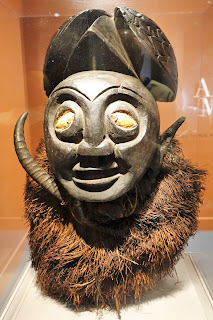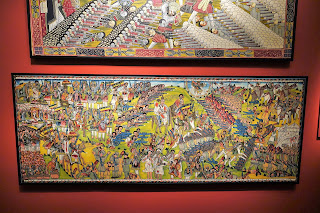Curse you, practitioners of the inexact science of weather forecasting! For the three-day Presidents Day holiday weekend, I really wanted to take advantage of the paid day off (no government shutdown!) to go out of town for a much-needed (in my mind, at least) break from frustrating rut of "learning" Amharic. My significant other, employing her Yunlin medical background, proclaimed that all my delicate psyche needed was some manning up, and announced that she didn't want to go anywhere for the three-day weekend. Oh well, there's always my daughter, so I went ahead with making plans for the two of us to spend Sunday and Monday in Richmond (avid readers of this blog, if there are any, might recall that the family made a day trip to Virginia's capital at the end of December, visiting the Virginia Museum of Fine Arts and picking up a pizza from Papa Murphy's - the fun never stops). The plan was to rent a car and see more of what Richmond is rumored to offer (Confederate memorials, hipster cafes and shops etc.).
Unfortunately, the weather forecast called for snow on Saturday and Sunday in this area. Although the prediction for Richmond was better, as Amber pointed out, we wouldn't want to return to Falls Church on slippery, uncleared roads - based on past experience with DC-area snowstorms, it was a pretty astute observation. So instead the decision was made to stay home for the last extended weekend until Memorial Day. Well, as it turned out, it didn't snow over the three days - parts of Saturday and Sunday were sunny (until it started to rain beginning on Sunday afternoon), and Monday was bright for the most part, though gusty at times.
Speaking of the holiday Monday, at Shu-E's suggestion we had lunch at a so-so Asian buffet restaurant. At the end of the meal, I broke open my fortune cookie to read the following:
"Take a vacation, you will have unexpected gains."
Son of a b....
In the meantime, the struggle to learn Amharic goes on, as I continue to lag behind my classmates. Being a small language in comparison to the likes of French, Spanish, Mandarin and Russian (even though it's spoken by more than 22 million people), there aren't that many teaching resources available for our instructor to use, so a lot of class time is spent discussing grammar structures. I'm the kind who needs rote exercises, drills and homework assignments to even have a chance at mastering some sort of proficiency in a language, and being left to seek out activities on my own isn't the best approach. There are also some neuropsychological issues that are in the process of (hopefully) being addressed, so at least I have some flimsy excuses to fall back on in the worst-case scenario. If you think I'm just whinging, you're probably right, but this BBC article does note that FSI considers Amharic a Group 3 language - only Group 4 languages like Arabic, Chinese, Korean and Japanese are considered more difficult for English learners.
Ah well, life goes on. Like when we went to Eden Center on one Saturday afternoon to see if any Tet-related activities were taking place. There weren't, but my daughter did get to pose in front of some decorations, while I got to sip a Thai iced tea on a cool, breezy afternoon:
The following day we returned to Eden Center for lunch at Gom Tang E, where the broth is apparently so delicious it's worth risking a zombie apocalypse:
At least something was happening on that Sunday, even if it was just a small lion-dancing team going from shop to shop:
The Saturday of the Presidents Day weekend saw Amber take part in the 2019 Chinese New Year Go Tournament 中國新年圍棋賽 at the National Go Center in Washington:
A reproduction of a Song Dynasty 宋朝 ink drawing called The Merchant, featuring scenes of Go playing, was hung on one of the walls during the tourney. The original is in the possession of the National Palace Museum 故宮博物院 in Taipei 台北:
During the lunch break, Amber and I went to District Taco. The sachet was a gift given to all the players - it reads píng'ān, meaning "safe and sound":
Walking around Tenleytown after lunch, we came across this mural illustrating scenes related to the area. If you have keen eyes, you'll notice Kermit the Frog in the upper right. Jim Henson's creation made his TV debut at a local station in 1955:
Amber ended up finishing second in her bracket:
On Sunday the two of us returned to the same area, this time having lunch at Seoul Spice. One can never have too much bibimbap. Apparently, the same is also true of kale, according to a one-star review of the restaurant I read online. The reason for the poor rating: the shop had run out of the trendy leaf cabbage. Life can challenging at times when you're a privileged white suburbanite:
My daughter shows off a purchase she made at Politics and Prose, one of the best independent bookshops in the District:
A 1929 blend of Tudor and Gothic Revival on Connecticut Avenue. According to Redfin, condos in this complex go for more than half a million dollars. Earlier, we walked by a three-bedroom, 2½ bath house on Nebraska Avenue that was valued at almost $1 million by Zillow. Like in many other metropolitan areas in the U.S. (excluding the Rust Belt, at least), housing prices are reaching ridiculous levels in Washington's desirable neighborhoods, pricing out people like us. Zillow says the rent estimate on such homes would eat up most of my monthly income, meaning that should I ever accept (or have forced on me) a domestic assignment, we'll either go broke or have to live far out in the suburbs:
A sentinel at a window along Connecticut Avenue...:
The snowstorm predicted over the President's Day weekend did eventually materialize, and it had the courtesy to come in early on a Wednesday morning, leading to the cancelation of classes for both Amber and myself (Shu-E, naturally, was less than overjoyed at this turn of events). This was the scene that greeted me as I went out onto our balcony at half-past eight that morning:
In total, Falls Church received 3.9 inches (9.9 centimeters) of snow, a trifling amount for someplace like Minneapolis or Vilnius, perhaps, but enough to cancel schools and shut down the federal government in this region. It's on days such as the one described that I don't miss having a car. We were here when Snowmageddon hit in January 2016, and it took us nearly 2½ hours to dig out our vehicle. The accumulated snow was much less this time, of course, but I still saw cars having difficulty maintaining traction in the Eden Center parking lot when my daughter and I went out for a walk after lunch:
Finally, on the first normal weekend following the three-day break the previous week, my family and I went out and did something meaningful...or at least my daughter and I did. On a chilly, wet Saturday morning, Amber and I rode the Metro into the District to visit the National Museum of African Art, a Smithsonian showcase of ceramics, masks, textiles and old and modern art from all over the continent. First things first, however, we headed over to the Smithsonian Castle for lunch, popping in to pay our respects to James Smithson, whose generous donation following his death led to the creation of the Smithsonian Institution. Surprisingly, Smithson, a British subject, never visited the United States during his lifetime - his remains were relocated to Washington, D.C. in 1904, nearly 75 years after his death:
The Castle Cafe was crowded, and all seats were occupied, so instead we walked several blocks away from the National Mall to have lunch at the Pennsylvania Avenue branch of the Elephant & Castle. I had the Yorkshire pudding (hidden underneath the roast beef strips), while my daughter ordered her Anglo-Irish favorite, shepherd's pie:
Bellies filled, we returned to the Mall and entered the National Museum of African Art, established in 1964:
Some of the highlights from the displayed collection included this magnificent face mask from either modern-day Angola or the Democratic Republic of the Congo. It represents a young woman incised with several examples of tattoos that are the work of the Chokwe people:
Apartheid Laboratory (1995):
The Blue Bra Girls (2012) by Egyptian artist Ghada Amer:
Untitled (2009) by Ghanaian artist El Anatsui, a wall sculpture made from discarded metal objects:
This 18th-century commemorative head of a king was fashioned out of copper alloy and iron by an Edo artist during the time of the Benin Empire:
This mask was fashioned by a Bamum artist sometime in the late 19th or early 20th century. The eyes are made from the silk of earth spiders, giving the figure an alien-like appearance:
An exquisite salt cellar dating from the 16th century. It was crafted by an Edo artist out of ivory:
This ceramic jar was made by a Nyoro artist in the mid-20th century. The reflection on the glass display case comes from a pool of water filled with coins:
Amber stands next to a Bamum male figure from Cameroon. It dates from the late 19th century:
The oldest piece we came across at the museum was this archer figure from Mali, which was made sometime between the 13th and 15th centuries:
Naturally, I was curious to see what the museum had from Ethiopia:
The answer was "some items, but not as many as I was hoping". These two panels depict the Battle of Adwa (1896), in which the Ethiopian forces routed Italian troops and preserved the country's independence. Ethiopia and Liberia were the only two African states not colonized by the Europeans during the Scramble for Africa:
An Amhara አማራ artist crafted this shield in the late 19th-early 20th century. The cloth and silver flourishes on it were unique to Ethiopia:
Homage to Russian Ballet, an oil-on-canvas work from 1968 by Afewerk Tekle አፈወርቅ ተክሌ, the first Ethiopian artist to garner attention in the post-World War II period:
Hallucination (1961) by Skunder Boghossian. The woman's crossed hands and seated posture evoke an association with the Virgin Mary:
St. George is often depicted riding a white horse and slaying a dragon in Ethiopian art. This woodcut-on-paper by Falaka Armide Yimer was created in 1960:
Auguries (2010) by Julie Mehretu:
Homme Carapace (1968), a ceramic sculpture by Etiyé Dimma Poulsen, a Danish sculptor born in Ethiopia:
For me, the most interesting examples of Ethiopian art are the religious symbols, such as this copper alloy processional cross from the 14th-15th centuries, crafted by an Amhara artist:
Amber poses with a couple of items we picked up from the museum gift shop. I haven't tried the coffee yet, but the music was surprisingly good, much better than the commercialized popular pap our Amharic teacher likes to play for us in class:
As for the National Museum of African Art, I would liked to have seen more examples of art from before the 19th and 20th centuries. Also, there seemed to be a disproportionate number of items from the region that is now Nigeria. Still, the museum is worth a visit and whetted my appetite for what I hope to see after we finally arrive in Addis Ababa አዲስ አበባ.
If you're wondering about the title of this blog post, here's the story: I went for a walk this afternoon on the Custis Trail, sucking on a See's Candies butterscotch lollipop. A woman remarked as I passed by that I looked like Telly Savalas, to which I replied in an appropriate manner, much to her amusement. If you're too young to understand to what I'm referring, just scroll down a little further...:


















































No comments:
Post a Comment